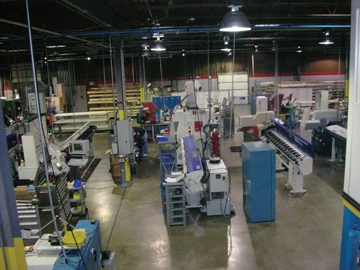
Medical device manufacturers are doing their homework in evaluating measurement comparators and vision systems. And, it appears that vision systems like the Galileo from Starrett, are becoming the norm for medical applications. The reason behind this is that vision systems are capable of measuring smaller parts with tighter tolerances at a much faster pace.
Generally, comparators use charts and a Mylar overlay for measuring. A part is put on a comparator, a drawing is placed on the screen and it's up to the inspector to determine if the part matches the drawing.
The Galileo Vision System takes the human element of error out of the equation and delivers accuracy of 3.4 microns or better. Results such as these are achieved through the mechanics of the Starrett system.
According to Starrett, the automated accuracy of the measurement and its repeatability is a strong advantage of the Galileo system. Using a comparator involves a manual process in which an operator is involved, using an eye for lining up the piece. Interpretation can vary from operator to operator.
For medical products such as surgical blades and bone drills, the Galileo employs its Video Edge Detection (VED) system, which scans the edge of the component, taking up to 300 points automatically and creates a best fit line through these points. Then, when a feature is measured - be it a line, an arc, a circle and so forth -- the results will be the same no matter who is running the machine.
Although there is a perception that video systems are difficult to operate, the Galileo CNS System includes powerful Metronics Quadra- Chek QC-5000 software which is extremely intuitive and has a MSWindows operating system.
Onyx Medical Corp., located in Memphis, TN, is a medical device manufacturer currently using the Galileo to verify dimensional accuracy of its products. The company manufactures orthopedic trauma implants and instruments, including half-pins, screws, drills, and guide wires for leading orthopedic companies worldwide.
Recently, Onyx has become involved with helping customers refine their cutting tool designs and making prototypes of them. In fact, the prototype business has become significant enough that Onyx has dedicated one of its Swiss turning machines strictly to prototype work.
When Onyx opened its doors sixteen years ago, it performed no CNC operations. Today, the company owns nine Swiss turning machines and four multi-axis grinders, among other machines.
Admittedly, parts have become more complex and cutting tools are notoriously difficult to inspect. Recently, Onyx accepted a special project that was an extraordinary cutting tool and extremely difficult to inspect. The company went through a process of evaluating different cutting tool measuring machines to properly inspect the tool.
Upon seeing a demonstration of the Galileo and learning about its many capabilities, Onyx was impressed with its visual inspection system. And after performing its own trials, the company found that the Galileo delivered consistent, accurate results in a much shorter time frame.
The more Onyx thought about the complexity of measuring parts with traditional techniques, the Galileo became the apparent choice for the company to expand its capabilities in measuring challenging parts and doing it repeatedly.
The objective of acquiring a visual inspection machine capable of checking complicated parts, improving repeatability of measurement, and reducing the workload on QC inspectors while increasing their productivity led Onyx to acquire Starrett's Galileo system. Today, the company views the Galileo as a useful asset that will provide a solid foundation for future growth. TMD
For more information on Starrett's Galileo System contact
The L.S. Starrett Company
Anthol, MA
www.starrett.com

Explore the June 2006 Issue
Check out more from this issue and find your next story to read.
Latest from Today's Medical Developments
- Birk Manufacturing achieves ISO 13485 recertification
- SW North America's BA 322i twin-spindle CNC
- The role of robotics in precision medical device manufacturing
- Swiss Steel Group’s UGIMA-X machinable stainless-steel sets
- #51 - Manufacturing Matters - The Impact of M&A in MedTech 2024
- Visual Components: 25 years of simulation and programming software innovation
- Zimmer Biomet announces definitive agreement to Acquire Paragon 28
- Discover an innovative technology for EMI/ESD/TVS suppression





